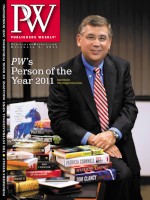John Lescroart’s 23rd book, The Hunter (Dutton), is his third thriller featuring San Francisco private investigator Wyatt Hunt.
Lescroart is unabashed about this latest: “I’m so thrilled with this book I can’t tell you.” And with good reason. It’s a compelling story that deftly intertwines mystery and suspense with real emotional resonance as Hunt, an orphan, investigates his past and discovers the truth about his birth parents.
John Lescroart’s books have sold more than 10 million copies, can be found in 75 countries, and are no strangers to the New York Times bestseller list. But his success has been a long time coming.
At a Polk Street cafe in San Francisco, Lescroart talks about his “long, slow start to writing,” which began as an undergraduate at the University of California at Berkeley (born in Texas, Lescroart has lived most of his life in California). “I wanted to be a literary writer,” he says. “I wrote a book in college and thought it was absolutely awful. Actually, I thought it was well written, but didn’t have a plot. So I said to myself, I’d better learn to write a plot.”
That was in 1970. His next effort had a plot, a historical thriller featuring Auguste Lupa, the son of Sherlock Holmes and Irene Adler (a neat fictional conceit that gets even neater with the implicit suggestion that Lupa is a young iteration of Nero Wolfe, a favorite of Lescroart’s). But Son of Holmes wouldn’t be submitted for publication for more than a decade; Lescroart wanted to write literary novels, not genre books.
And there was music. Lescroart spent most of his 20s fronting a group called Johnny Capo and His Real Good Band in San Francisco. “I loved being a musician,” he says, “but I quit abruptly when I turned 30.” He still wanted to pursue his initial dream of becoming a writer.
He promptly finished Sunburn, a literary novel set in Spain, and the unpublished manuscript won the Joseph Henry Jackson Award for Best Novel by a California Author in 1978. A small house, Pinnacle Books, in Los Angeles, published it as a mass market paperback in 1981, and John Lescroart, author, was launched.
Barely. He was in print, but the book didn’t achieve much commercial success, nor was he able to interest the New York publishing houses in his work. In the mid 1980s, his wife, Lisa, urged him to submit his Auguste Lupa thriller, Son of Holmes. “I said, ‘No, I’m a literary guy!’ ”
But he did dust off the manuscript, which wound its way to print through the most circuitous of routes: a colleague of his wife was married to a Washington, D.C., lawyer, who had an associate, Gail Ross, who wanted to become a literary agent. In 1986, Donald I. Fine published the book, and John Lescroart, genre novelist, was launched.
“From then on, I’ve been a writer,” he notes. “But it took five more years to actually make a living from my work.” He maintained a punishing schedule in the late 1980s, writing 6–8 a.m. in the morning, working as the supervisor of the word processing department of a Los Angeles law firm and taking on freelance word processing at night. Lescroart wrote three more novels, including Dead Irish (Donald I. Fine, 1989), his first novel to feature endearingly named Dismas Hardy, the San Francisco ex-cop turned private eye.Then, in 1989, body surfing at Seal Beach, he contracted spinal meningitis. The doctors gave him two hours to live.
“I was in a coma for 11 days,” he says. “And when I woke up, I decided, if I’m going to be a writer, I’m going to do it now.” And with that, Lescroart moved back to San Francisco (he and his wife now live in Davis, Calif.), and he wrote 12 more Dismas Hardy novels, three novels featuring attorney Abe Glitski, one starring Gina Roake (a partner of Hardy’s), and the first two Wyatt Hunt books.
Lescroart, who turns 64 in January, is not stopping now. He’s already working on another Dismas Hardy thriller, scheduled for publication in January 2013.
“I had nothing but second jobs until I was 45,” he says. “This is heaven!”



 Volume 258
Issue 49
12/05/2011
Volume 258
Issue 49
12/05/2011





